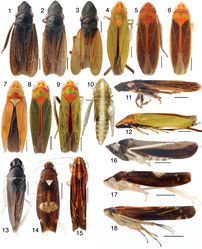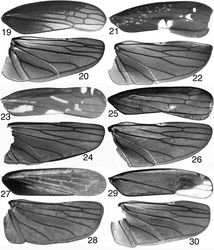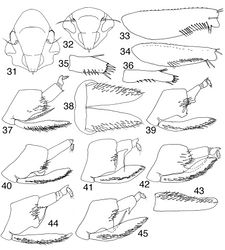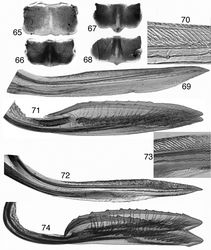Tungurahualini
| Notice: | This page is derived from the original publication listed below, whose author(s) should always be credited. Further contributors may edit and improve the content of this page and, consequently, need to be credited as well (see page history). Any assessment of factual correctness requires a careful review of the original article as well as of subsequent contributions.
If you are uncertain whether your planned contribution is correct or not, we suggest that you use the associated discussion page instead of editing the page directly. This page should be cited as follows (rationale):
Citation formats to copy and paste
BibTeX: @article{Dietrich2011ZooKeys124, RIS/ Endnote: TY - JOUR Wikipedia/ Citizendium: <ref name="Dietrich2011ZooKeys124">{{Citation See also the citation download page at the journal. |
Ordo: Hemiptera
Familia: Cicadellidae
Name
Dietrich, 2011 trib. n. – Wikispecies link – ZooBank link – Pensoft Profile
Type genus
Tungurahuala Kramer
Description
Medium-sized leafhoppers (~6–8 mm), body depressed, head produced, face horizontal in profile, antenna shorter than width of head, frontoclypeus with transverse carina forming distinct shelf in lateral view (Figs 11–12, 31–32); anteclypeus extended to or slightly beyond lower margin of gena; lorum with lateral margin not extended to lateral margin of gena; rostrum short, not surpassing front trochanters. Front femur (Figs 33–34) with AM1 and AV1 enlarged, row AV with 0–1 preapical setae; intercalary row with 12 or more slender setae; hind tarsomere I without platellae, pecten with four tapered macrosetae. Forewing (Figs 27, 29) vein R with three branches; two r-m crossveins present; appendix absent or very narrow; hind wing vein R2+3 complete, extended to wing apex. Male pygofer (Fig. 37) with well developed ventral appendage, dorsal appendage absent, several macrosetae present distally; anal tube usually with paired ventrolateral processes; valve (Fig. 38) short, transverse, broadly fused to pygofer; subgenital plate broadest near base in ventral view, expanded medially in lateral view, with numerous scattered stout submarginal setae; connective stem as long as or longer than arms; style (Figs 47–51) cheliform with preapical lobe greatly enlarged and preapical tooth distinct. Female first valvulae with dorsal sculpturing strigate (Fig. 70) or concatenate (Fig. 73); second valvulae (Figs 71, 74) with small serrations between larger teeth.
Notes
Tungurahualini resemble other Mileewinae in having the ocelli on the crown distant from the margin, the frontoclypeus and clypellus strongly convex, the forewing with the inner apical cell elongate and parallel-sided, the hind femur with macrosetal formula 2+1+1, and the second valvulae with the toothed distal blades longer than the basal fused section. They differ from other Mileewinae in having the head depressed with the face horizontal, the frontoclypeus with a transverse carina (Figs 31–32) forming a distinct shelf in profile, the first hind tarsomere pecten with spiniform setae (platellae absent), and the subgenital plate with numerous scattered macrosetae (see also Key).
A previous cladistic analysis (Dietrich 2004[1]) consistently grouped the two genera included in Tungurahualini together in a clade also comprising the single included representative of Makilingiini. A more recent morphology-based analysis of the entire family Cicadellidae (Dietrich et al. 2010[2]) placed Tungurahualini within a paraphyletic assemblage, comprising the other tribes here included in Mileewinae, that gave rise to Cicadellinae and Typhlocybinae. More detailed analysis of this entire lineage will be needed to further elucidate the phylogenetic status of Mileewinae and its included tribes.
Tungurahualini resemble Nirvanini (Evacanthinae, sensu Dietrich 2004[1]) in having the body depressed with the head strongly produced and the face horizontal. The male genitalia also resemble those of Nirvanini, particularly the structure of the style (apex foot-shaped) and aedeagus (base with paired dorsal processes). However, unlike Nirvanini (and other Evacanthinae), the crown of the new tribe lacks a distinct marginal carina, the ocelli are distant from the margin, the face lacks a median longitudinal carina, crossvein r-m1 is present in the forewing, and the front femur lacks enlarged basal setae in row AV. The presence of spiniform setae rather than platellae at the apex of the first hind tarsomere is an unusual trait shared with some Oriental Evacanthini, but evacanthines differ in having the crown distinctly elevated mesad of the eyes, with marginal and submarginal carinae, and ocelli near the crown margin.
Species of Tungurahualini are presently known only from cloud forests in the northern and central Andean regions of the New World tropics.
Key to genera of Tungurahualini
Taxon Treatment
- Dietrich, C; 2011: Tungurahualini, a new tribe of Neotropical leafhoppers, with notes on the subfamily Mileewinae (Hemiptera, Cicadellidae) ZooKeys, 124: 19-39. doi
Other References
- ↑ 1.0 1.1 Dietrich C (2004) Phylogeny of the leafhopper subfamily Evacanthinae with a review of Neotropical species and notes on related groups (Hemiptera: Membracoidea: Cicadellidae). Systematic Entomology 29: 455-487. doi:10.1111/j.0307-6970.2004.00250.x
- ↑ Dietrich C, Dmitriev D, Rakitov R, Takiya D, Webb M, Zahniser J (2010) Phylogeny of Cicadellidae (Hemiptera: Cicadomorpha: Membracoidea) based on morphological characters. In: Soulier-Perkins A Ouvrard D Bourgoin T (Eds) 13th International Auchenorrhyncha Congress Abstracts, Museum National d'Histoire Naturelle, Paris, 48–49.
Images
|




